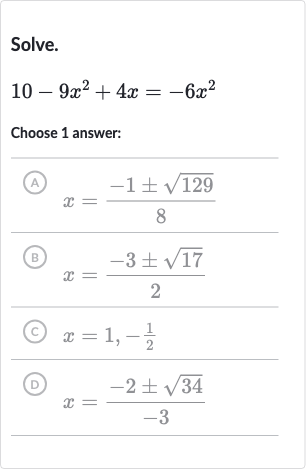AI tutor
Full solution
Q. Solve.Choose answer:(A) (B) (C) (D)
- Combine like terms: First, let's combine like terms by moving all terms to one side of the equation to set it equal to zero.Add to both sides to combine the terms.Simplify the equation.
- Rearrange in standard form: Now, let's rearrange the terms in standard quadratic form .
- Identify coefficients: We need to solve for using the quadratic formula, . First, identify the coefficients
a ,b , andc .\newline a = ,− 3 -3 b = ,4 4 c = 10 10 - Substitute into quadratic formula: Now, substitute the values of
a a b b c c x = − ( 4 ) ± ( 4 ) 2 − 4 ( − 3 ) ( 10 ) 2 ( − 3 ) x = \frac{{-\left(4\right) \pm \sqrt{{\left(4\right)^2 - 4\left(-3\right)\left(10\right)}}}}{{2\left(-3\right)}} - Calculate discriminant: Calculate the discriminant (the part under the square root).
\newline ( 4 ) 2 − 4 ( − 3 ) ( 10 ) (4)^2 - 4(-3)(10) \newline 16 + 120 16 + 120 \newline 136 136 - Substitute discriminant into formula: Now, substitute the discriminant back into the quadratic formula.
\newline x = − 4 ± 136 − 6 x = \frac{{-4 \pm \sqrt{{136}}}}{{-6}} - Simplify square root: Simplify the square root of the discriminant.
136 = 4 × 34 = 2 × 34 \sqrt{136} = \sqrt{4 \times 34} = 2 \times \sqrt{34} - Substitute simplified square root: Substitute the simplified square root back into the quadratic formula.
x = − 4 ± 2 ⋅ 34 − 6 x = \frac{{-4 \pm 2 \cdot \sqrt{34}}}{{-6}} - Divide all terms by
− 2 -2 − 2 -2 \newline x = 2 ± 34 3 x = \frac{2 \pm \sqrt{34}}{3} - Final answer: The final answer is in the form of two possible solutions for
x x x = 2 + 34 3 x = \frac{{2 + \sqrt{{34}}}}{3} x = 2 − 34 3 x = \frac{{2 - \sqrt{{34}}}}{3}
More problems from Solve a quadratic equation using the quadratic formula
QuestionGet tutor help
QuestionGet tutor help
QuestionGet tutor help
QuestionGet tutor help
QuestionGet tutor help
QuestionGet tutor help
QuestionGet tutor help
QuestionGet tutor help
QuestionGet tutor help

